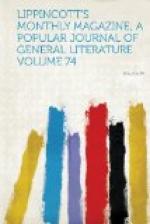How can my Muse want subject
to invent,
While thou dost
breathe, that pour’st into my verse
Thine own sweet argument,
too excellent
For every vulgar
paper to rehearse?
That is, kindly explains Mr. Massey—lest we should be tempted to accept the obvious meaning of the lines, that the poet could not want a subject while his friend lived, whose worth was too great for every ordinary writing to celebrate fitly—“that is, the new subject of the earl’s suggesting and the new form of the earl’s inventing are too choice to be committed to common paper; which means that Shakespeare had until then written his personal sonnets on slips of paper provided by himself, and now the excelling argument of the earl’s love is to be written in Southampton’s own book”! Perhaps it means that Shakespeare had taken to gilt-edged, hot-pressed, double-scented Bath note.
Mr. Massey’s ingenuity in getting over a difficulty is as great as his faculty of construction. Having assumed Lady Rich (that Stella whose golden hair makes half the glory of Sidney’s verse) to be the “black beauty” of the Sonnets, he finds that Sonnet 130 perversely says, “If hairs be wires, black wires grow on her head”—a bit of evidence that would seem to upset this theory. But Mr. Massey is not to be put down so easily. This is ironical, he says in effect; Shakespeare did not mean this; “it is a bit of malicious subtlety to call the lady’s hair black wires, which was so often besung as golden hair; and she had been so vain of its mellow splendor! ... And there is the ‘if’ to be considered—’much virtue in an if’!—’If hairs be wires,’ says the speaker, ‘black wires grow on her head!’ So that the ‘black’ is only used conditionally, and the fact remains that ‘hairs’ are not ‘wires.’” If we are to interpret Shakespeare in this manner, where is such foolery to cease?
To sum up the principal facts of Mr. Massey’s elaborate theory in a few words, we find that he considers the Sonnets to be dedicated to William Herbert, earl of Pembroke, as “their only begetter” (or obtainer) for the publisher, Mr. Thomas Thorpe; that they consist properly of two series, the first written for Henry Wriothesley, earl of Southampton, the second for the earl of Pembroke; that they begin with the poet’s advice to Southampton to marry; that when the earl fell in love with Elizabeth Vernon, he suggested a new argument (see Sonnet 38), wherein is no such thing as a new argument, by the way; and that then the poet begins to write love-poems in the person of his friend. This continues up to the year 1603, when the earl of Southampton was released from prison, the dramatic sonnets being interspersed with personal ones. These dramatic sonnets also include sonnets written for Elizabeth Vernon of and to Penelope Lady Rich, of whom she is supposed to be jealous; sonnets from Southampton to herself upon the lovers’ quarrel, and the desperate flirtation




